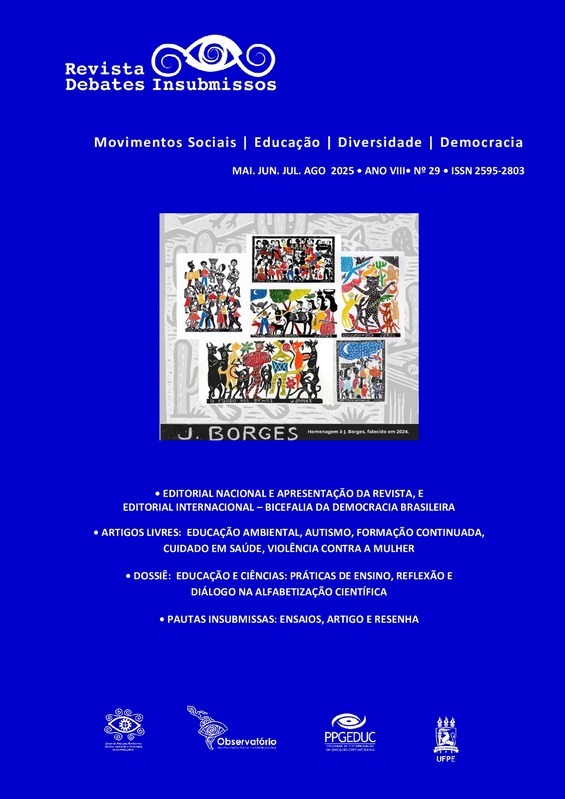RELATO DE EXPERIÊNCIA: SEQUÊNCIA DIDÁTICA NO ESTUDO DE ELETROSTÁTICA VIA GOOGLE CLASSROOM
DOI:
https://doi.org/10.32359/debin2025.v8.n29.p187-202Palavras-chave:
Sequência Didática, Eletrostática, Google ClassroomResumo
Este artigo apresenta os resultados de uma experiência didática que envolveu a elaboração e aplicação de uma Sequência Didática (SD) fundamentada nos pressupostos de Zabala (2015), voltado ao uso de recursos tecnológicos aplicado aos conceitos básicos de eletrostática. A proposta foi desenvolvida com uma turma do 2º ano do Ensino Médio da Escola Estadual de Ensino Fundamental e Médio Cristo Trabalhador, situada em Abaetetuba, Pará, Brasil. A implementação da SD ocorreu por meio da plataforma Google Classroom, que possibilitou a organização e o acesso às atividades. Foram utilizados diversos recursos, como animações, simuladores da plataforma PhET Interactive Simulations, videoaulas e experimentos com materiais de baixo custo, a fim de promover a aprendizagem ativa e significativa. A análise dos resultados evidenciou que a utilização combinada de recursos tecnológicos e atividades práticas favorece a construção do conhecimento, tornando as aulas mais dinâmicas, interativas e alinhadas às necessidades dos alunos. Além disso, a abordagem proposta contribui para a superação do ensino tradicional, ampliando o repertório pedagógico dos docentes e proporcionando um processo de ensino-aprendizagem mais crítico, reflexivo e contextualizado.
Referências
BRASIL. Base Nacional Comum Curricular. Brasília: MEC/SEF, 2018.
CAMARGO, Fausto; DAROS, Thuinie. A sala de aula inovadora [recurso eletrônico]: estratégias pedagógicas para fomentar o aprendizado. Porto Alegre: Penso, e-PUB, 2018.
MOREIRA, Marco Antonio. Organizadores prévios e aprendizagem significativa. Revista Chilena de Educación Científica, v. 7, n. 2, p. 23-30, 2008. Disponível em: http://www.if.ufrgs.br/~moreira/. Acesso em: 15 mai. 2022.
PHET INTERACTIVE SIMULATIONS. Lei de Coulomb - Eletrostática. University of Colorado Boulder. Disponível em: https://phet.colorado.edu/pt_BR/simulation/coulombs-law. Acesso em: 26 mai. 2025.
SOUSA, Cleydson José da Silva; SILVA, Shirsley Joany dos Santos da; BRAGA, Lélio Favacho; JÚNIOR SILVA, Carlos Alberto Brito da; BRAGA, Aline Nascimento; BRAGA, Alessandra Nascimento. Relato de experiência: sequência didática no estudo de cinemática e dinâmica mediado pelo uso de simuladores virtuais. A Física na Escola, [S. l.], v. 21, n. 1, p. 230002-1, 2023. DOI: https://doi.org/10.59727/fne.v21i1.2. Disponível em: https://fisicanaescola.org.br/index.php/revista/article/view/2. Acesso em: 23 maio 2025.
SANTANA, Rosimar Magalhães. SD - Ativa Sequência Didática Ativa - Referência para o uso da Sala de Aula Invertida. Roraima: UERR, E-book, 2023.
SCHÖN, Donald A. Formar professores como profissionais reflexivos. In: NÓVOA, António (org.). Os professores e sua formação. Lisboa: Publicações Dom Quixote, 1992. p. 77-91.
ZABALA, Antoni. A prática educativa: como ensinar. Penso Editora, 2015.
VYGOTSKY, Lev Semenovich. A construção do pensamento e da linguagem. São Paulo. Editora Martins Fontes, 2001.
Downloads
Publicado
Como Citar
Edição
Seção
Licença

Este trabalho está licenciado sob uma licença Creative Commons Attribution-NonCommercial-NoDerivatives 4.0 International License.



